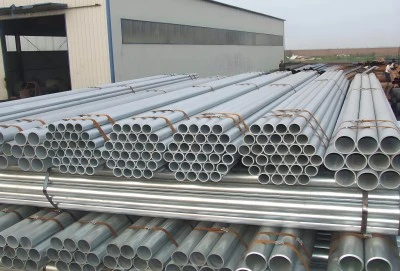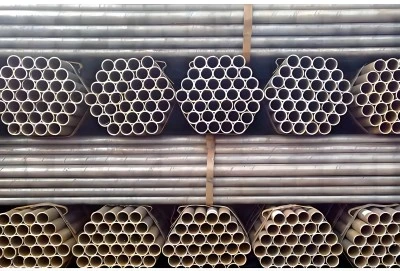ASTM A787 tubing is a widely used material in various industrial applications, known for its specific composition and performance characteristics. This article delves into the chemical makeup of A787 tubing, explores how its composition affects its performance, and examines the manufacturing process behind these versatile tubes.
|
|
|
Chemical elements specified in ASTM A787
ASTM A787 tubing is composed of a carefully balanced mixture of chemical elements, each contributing to the material's overall properties. The primary elements found in A787 tue include:
- Carbon (C): 0.25% maximum
- Manganese (Mn): 1.20% maximum
- Phosphorus (P): 0.035% maximum
- Sulfur (S): 0.035% maximum
These percentages represent the maximum allowable content for each element. The actual composition may vary within these limits, depending on the specific grade and intended application of the A787 tubing.
Carbon plays a crucial role in determining the strength and hardness of the steel. The relatively low carbon content in A787 tubing (0.25% maximum) allows for good formability and weldability while still maintaining adequate strength. Manganese contributes to the steel's strength and hardenability, while also helping to prevent the formation of iron sulfides, which can lead to brittleness.
Phosphorus and sulfur are typically considered impurities in steel. Their content is limited to minimize their negative effects on the material's properties. Excessive phosphorus can lead to brittleness, while high sulfur content can cause hot shortness, a condition where the steel becomes brittle at high temperatures.
It's worth noting that while these are the primary elements specified in ASTM A787, other alloying elements may be present in small quantities to fine-tune the material's properties for specific applications.
How does composition affect ASTM A787 tubing performance?
The chemical composition of ASTM A787 tubing directly influences its mechanical properties and overall performance. Let's examine how each element contributes to the tubing's characteristics:
Carbon (C): As the primary hardening element in steel, carbon significantly affects the strength and hardness of A787 tubing. The relatively low carbon content in this specification allows for good formability and weldability, making it easier to shape and join the tubing. However, it still provides sufficient strength for many applications.
Manganese (Mn): Manganese enhances the strength and hardenability of the steel. It also helps to prevent the formation of iron sulfides, which can lead to brittleness. The presence of manganese in A787 tubing contributes to its overall toughness and wear resistance.
Phosphorus (P) and Sulfur (S): While these elements are considered impurities, their presence in small, controlled amounts can have some benefits. Phosphorus can slightly increase the strength and hardness of the steel, while sulfur can improve machinability. However, their content is strictly limited in A787 tubing to prevent negative effects on ductility and toughness.
The balanced composition of ASTM A787 tubing results in a material with the following performance characteristics:
- Good formability: The low carbon content allows the tubing to be easily shaped and formed without cracking or excessive work hardening.
- Excellent weldability: A787 tubing can be readily welded using various methods, making it versatile for fabrication and assembly.
- Adequate strength: While not as strong as some high-carbon steels, A787 tube offers sufficient strength for many applications.
- Corrosion resistance: The controlled composition helps maintain a consistent surface quality, which can be beneficial for corrosion resistance, especially when combined with appropriate surface treatments or coatings.
- Consistent quality: The tight control on chemical composition ensures predictable and repeatable performance across different batches of A787 tubing.
These properties make ASTM A787 tubing suitable for a wide range of applications, including structural supports, fluid transfer systems, and various mechanical components.
Manufacturing process details for ASTM A787 tubes
The manufacturing process for ASTM A787 tubes is a carefully controlled sequence of operations designed to produce tubing with consistent properties and high quality. Let's explore the key steps involved in creating A787 tubing:
1. Raw Material Selection: The process begins with the careful selection of raw materials. High-quality steel billets or coils with the appropriate chemical composition are chosen as the starting material for A787 tubing production.
2. Heating: The steel is heated to a high temperature, typically around 1200°C (2192°F), in a furnace. This heating process makes the steel malleable and ready for forming.
3. Forming: The heated steel is then formed into a tube shape. This can be done through various methods, depending on the specific manufacturing process:
- Electric Resistance Welding (ERW): For smaller diameter A787 tubing, the ERW process is often used. In this method, the steel is rolled into a cylindrical shape and welded along the seam using electric current to heat and fuse the edges.
- Seamless Pipe Manufacturing: For some applications, A787 tubing may be produced using seamless pipe manufacturing techniques. This involves piercing a solid steel billet to create a hollow tube without a welded seam.
4. Sizing and Straightening: After the initial forming, the tubing goes through sizing rolls to achieve the precise diameter and wall thickness required by the ASTM A787 specification. The tubes are also straightened to ensure they meet straightness tolerances.
5. Heat Treatment: Depending on the specific grade and required properties, A787 tubing may undergo heat treatment processes such as normalizing or annealing. These treatments help to refine the grain structure and relieve internal stresses, improving the material's mechanical properties and formability.
6. Surface Treatment: The tubing may undergo various surface treatments to enhance its appearance and corrosion resistance. This can include pickling to remove scale, polishing for a smooth finish, or applying protective coatings.
7. Testing and Inspection: Throughout the manufacturing process, A787 tubing undergoes rigorous testing and inspection to ensure it meets all the requirements of the ASTM A787 specification. This includes:
- Chemical composition analysis
- Mechanical property testing (e.g., tensile strength, yield strength, elongation)
- Non-destructive testing (e.g., ultrasonic or eddy current testing for weld integrity)
- Dimensional checks
- Visual inspection for surface defects
8. Finishing and Packaging: Finally, the A787 tubing is cut to the required lengths, deburred, and prepared for shipping. Proper packaging ensures the tubing is protected during transportation and storage.
This manufacturing process is designed to produce A787 tubing with consistent quality and properties, meeting the stringent requirements of the ASTM specification. The careful control of each step, from raw material selection to final inspection, ensures that the resulting tubing is suitable for its intended applications in various industries.
Understanding the composition and manufacturing process of ASTM A787 tubing is essential for engineers, designers, and procurement professionals working with this material. This knowledge can help in selecting the right tubing for specific applications and ensuring optimal performance in various industrial settings.
For those seeking high-quality steel pipes and tubes, including ASTM A787 tubing, Longma Group stands out as a leading manufacturer. As one of China's premier ERW/LSAW steel pipe manufacturers since 2003, Longma Group specializes in producing large-diameter, thick-walled, double-sided, sub-arc-seam welding steel pipes, including LSAW (Longitudinal Submerged Arc Welded) and ERW steel pipes. With an impressive annual output exceeding 1,000,000 tons by the end of 2023, Longma Group has the capacity and expertise to meet diverse industrial needs. For more information or to discuss your specific requirements, please contact Longma Group at info@longma-group.com.














